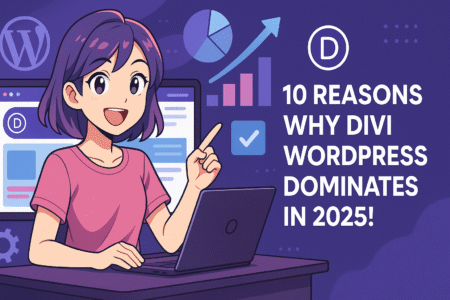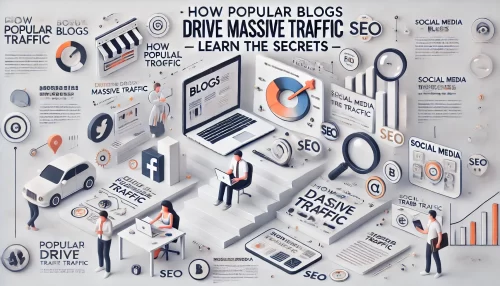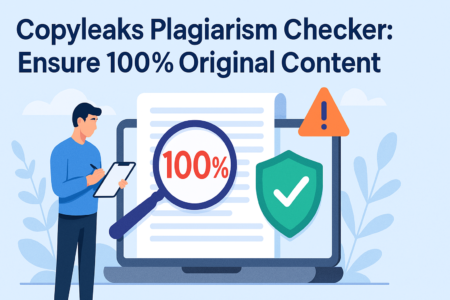Table of Contents
Quillbot Rewriter has become one of the most talked-about tools in the SEO community — but is it really safe for your website’s rankings?
If you’ve ever used Quillbot to paraphrase content or polish an article, you might wonder: could it actually hurt your SEO instead of helping it?
In this article, we’ll unpack how Quillbot’s AI rewriting affects search optimization, what Google experts think about AI-generated content, and how to use it smartly without putting your site at risk.
Understanding How Quillbot Rewriter Works
Before deciding whether Quillbot Rewriter is safe for SEO, it’s important to understand how it actually works.
In short, Quillbot uses artificial intelligence (AI) — specifically machine learning and Natural Language Processing (NLP) — to rewrite text while preserving the original meaning.
Quillbot isn’t a content spinner in the old-school sense. It doesn’t just swap words with synonyms. Instead, it rephrases sentences based on context, tone, and readability — almost like a human editor but with algorithmic precision.
How Quillbot Rewrites Content Using AI
At its core, Quillbot uses a combination of language models and semantic analysis. In plain English, it reads your sentence, interprets its meaning, and then rewrites it using different vocabulary or structure while keeping that meaning intact.
For example, if you input:
“Quillbot helps users improve their writing by paraphrasing text.”
It might output:
“Quillbot assists users in enhancing their writing through text rephrasing.”
That’s more than word swapping — it’s a structural rewrite.
Here’s what’s happening behind the scenes:
- Sentence Breakdown: The AI divides your sentence into tokens (words or short phrases).
- Meaning Mapping: It predicts the contextual meaning using NLP.
- Reconstruction: It rebuilds the sentence with fresh phrasing that still matches the original intent.
- Optimization: Depending on the selected mode (Fluency, Creative, Formal, etc.), it adjusts style and tone.
In Quillbot’s UI, you’ll see options like “Standard,” “Fluency,” and “Creative” modes in the top toolbar. Each one applies a slightly different AI rewriting logic — for instance, Fluency prioritizes grammar and readability, while Creative focuses on variation.
This flexibility is what makes Quillbot so popular among writers, marketers, and students. But it’s also what raises SEO concerns — especially when rewriting entire articles rather than using it as a support tool.
What Makes Quillbot Different from Other Paraphrasing Tools
Most traditional rewriters — think of tools like Spinbot or old SEO “spinners” — rely on mechanical synonym swapping. Quillbot, on the other hand, uses contextual paraphrasing.
That means it actually “understands” the text to some extent, instead of blindly rephrasing it. Because of this, Quillbot often produces grammatically coherent, natural-sounding sentences that still carry the original meaning.
Three key differentiators make it stand out:
- AI-Powered NLP Engine: It doesn’t just rewrite; it interprets meaning before rewording.
- User Control: You can adjust the “Synonym Slider” at the bottom of the interface to control how aggressive the rewriting is.
- Tone Sensitivity: It respects tone. For example, a formal blog post won’t suddenly sound casual unless you tell it to.
From my experience, that last point is a big deal. Many rewriting tools destroy a brand’s tone of voice. Quillbot, while not perfect, handles tone preservation surprisingly well when used in moderation.
Common Use Cases for Quillbot in SEO and Content Creation
When used responsibly, Quillbot can be a supportive SEO tool — not a shortcut.
Here are some real-world ways I’ve seen it used effectively:
- Improving Readability: Rewriting long, clunky sentences into smoother, shorter ones.
- Avoiding Repetition: Paraphrasing recurring phrases across multiple articles.
- Optimizing for Featured Snippets: Rewording key sentences to be more concise or question-based.
- Meta Description Polishing: Quickly rephrasing to fit character limits
- Localization: Adjusting text tone for different English dialects (e.g., US vs UK).
A quick example: from the Quillbot dashboard, you can paste your meta description into the paraphraser, set the mode to Fluency, and adjust the synonym slider to 2 or 3. This gives you a grammatically clean version without over-altering your keywords.
What I don’t recommend is using Quillbot to rewrite entire blog posts or plagiarized content. That crosses the line from “optimization” to “automation abuse,” which can put your SEO performance at risk.
The Role of Natural Language Processing in Quillbot’s Accuracy
Natural Language Processing (NLP) is the brain behind Quillbot’s rewriting magic. It allows the tool to understand language structure and semantics — the relationship between words and their meanings.
Here’s why NLP matters for SEO content:
- Context Retention: It ensures rewritten text stays faithful to the original message.
- Readability: It produces sentences that flow naturally, which helps keep readers engaged.
- Semantic Relevance: It helps Google understand your content’s topic, maintaining your SEO context.
In essence, NLP is what separates a “smart rewrite” from an SEO disaster. When Quillbot uses NLP well, your text still makes sense to both readers and algorithms — which is exactly where AI writing and SEO intersect safely.
Does Google Penalize AI-Rewritten Content?
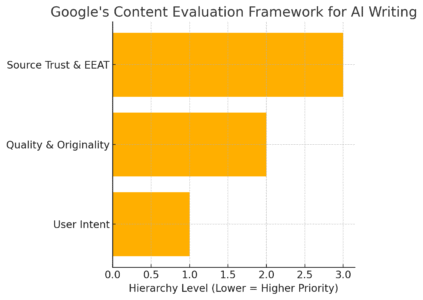
Now that we understand how Quillbot works, let’s face the bigger question: Does Google penalize content rewritten by AI?
The answer isn’t black and white. Google doesn’t automatically punish AI-assisted writing. But it does penalize low-quality, auto-generated, or “mass-produced” content — which includes poorly rewritten articles.
Google’s Official Stance on AI and Machine-Generated Text
Google has publicly stated (through its Search Central Blog and John Mueller’s comments) that AI-generated content is acceptable if it’s valuable, original, and written for users — not algorithms.
In short, the issue isn’t whether a human or a bot wrote it. The issue is quality and intent.
As of 2024, Google’s EEAT guidelines — Experience, Expertise, Authoritativeness, and Trustworthiness — apply equally to AI-assisted content. If your rewritten text provides genuine value, it’s fine. If it’s generic, misleading, or spammy, it’s not.
So, Quillbot itself isn’t the problem. It’s how you use it.
How Search Algorithms Detect Paraphrased or Rewritten Content
Google’s algorithms are smarter than most people realize. They don’t just check for duplicate words; they analyze semantic similarity — meaning they can detect when two texts are saying the same thing using different words.
This means that if you use Quillbot to mass-rewrite content without adding new insights, structure, or user value, Google can likely spot it.
The algorithm looks at things like:
- Topic redundancy: Is this content offering anything new compared to what’s already indexed?
- Semantic overlap: Are sentence structures and meanings too close to existing text?
- Behavioral signals: Do readers bounce quickly because the content feels off or generic?
AI detectors like Originality.ai and GPTZero use similar techniques. They analyze “burstiness” (human-like variation in sentence length) and “perplexity” (how predictable the text is). High predictability usually signals AI rewriting.
Why Original Context Still Matters in SEO Content
Even the best AI tool can’t replicate human context. Context is what connects facts, emotion, and nuance into something meaningful.
When rewriting with Quillbot, it’s easy to lose subtle details — tone, local examples, or audience intent — that make your content truly resonate. This is why I always recommend using Quillbot as an assistant, not an author.
Think of it like this:
- Quillbot = your grammar and phrasing co-pilot
- You = the pilot who provides strategy, tone, and insight
Maintaining context means editing the AI’s output, re-inserting your brand personality, and ensuring keyword intent remains intact. That’s how you stay on Google’s good side.
Expert Insights on Avoiding AI Content Penalties
Many SEO professionals (including Aleyda Solis, Lily Ray, and Marie Haynes) agree that AI-assisted writing can rank well — if it’s human-guided.
Here are some best practices experts recommend:
- Add Human Touches: Include personal experience, examples, or original research after rewriting.
- Fact-Check Thoroughly: Quillbot can accidentally distort data or phrasing — always verify sources.
- Run Quality Checks: Tools like SurferSEO or Clearscope help ensure rewritten content still aligns with top-ranking topics.
- Maintain Authorship Signals: Use a real author name and author bio to build EEAT trust.
As one expert put it, “Google doesn’t care who wrote it — only whether it deserves to be read.”
Pro Insight: I recommend using Quillbot for polishing — not producing — your SEO content. Write your draft first, then run select paragraphs through Quillbot’s Fluency or Formal mode to tighten up readability. Always review the rewritten output line by line to make sure your original meaning and SEO intent remain untouched.
Evaluating Quillbot’s Impact on SEO Rankings
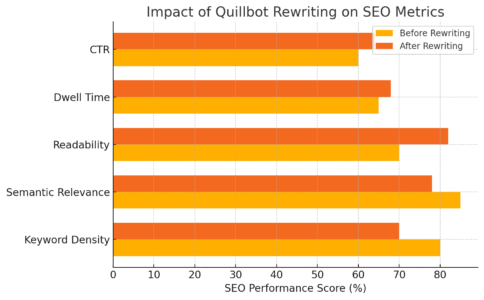
Let’s be real for a second — SEO is all about balance. You want your content to sound natural, flow beautifully, and still hit the right keywords.
That’s where Quillbot Rewriter often enters the conversation.
But can it actually help with SEO rankings, or does it quietly sabotage them behind the scenes? The truth depends on how you use it.
How Rewriting Affects Keyword Optimization and Topical Relevance
When you rewrite content with Quillbot, the first thing to understand is that AI can unintentionally alter or dilute your keyword targeting.
For instance, if your original sentence reads:
“This SEO strategy improves organic traffic for small businesses.”
Quillbot might change it to:
“This optimization method boosts visibility for small companies.”
Sounds fine, right? But notice what disappeared — the keyword SEO strategy. Google relies on those exact matches and related entities to understand your topic.
Here’s what tends to happen in practice:
- Primary Keywords Get Replaced: Quillbot substitutes them with synonyms, which can hurt ranking potential if you’re not careful.
- Semantic Relevance May Drift: The rewritten sentence might move away from your main topic cluster.
- Keyword Density Changes: The balance between readability and optimization can be lost.
Quick tip: I always suggest reviewing each rewritten section manually. In Quillbot’s interface, keep your keyword list open in another tab or notepad. After rephrasing, skim through your draft and make sure essential keywords — like your focus keyword Quillbot Rewriter — still appear naturally in the text.
The Risk of Losing Semantic Meaning During Paraphrasing
Search engines like Google don’t just read words; they read intent. When Quillbot paraphrases, it sometimes shifts the semantic meaning, which is the underlying context of your content.
Let’s say your blog is about “AI tools for SEO.” If you paraphrase aggressively, Quillbot might reword sections to sound like a general “AI productivity” article instead. Suddenly, your piece loses its topical focus.
The risk is highest when you use the Creative or Expand modes inside Quillbot. These modes are designed to add variety, but they can wander off-topic.
What I usually do is:
- Rewrite using Standard or Fluency mode.
- Compare the rewritten output with the original paragraph side by side.
- Reinsert lost SEO cues — like “on-page SEO,” “keyword intent,” or “Google ranking signals.”
By doing that, you get the clarity of AI assistance without losing the meaning Google actually values.
Can Quillbot-Rewritten Content Pass Google’s Quality Tests?
Let’s clear up one misconception — Google doesn’t automatically penalize content rewritten by AI. What it does penalize is low-quality, repetitive, or contextless content.
If your Quillbot rewrite results in bland, filler-style text that doesn’t teach, inform, or help the reader, Google’s Helpful Content System will likely devalue it.
To pass quality tests, your content must hit three signals:
- Relevance: It should clearly address a user’s intent.
- Depth: It should add genuine insight, not surface-level phrasing.
- Authenticity: It should sound human, not stitched together by algorithms.
In my experience, you can pass Google’s filters if you use Quillbot for micro-edits — tightening long sentences, improving flow, or adjusting tone — instead of full rewrites.
I often do this:
Write my original paragraph → Run it through Fluency mode → Recheck keyword presence and tone → Publish.
Used like that, Quillbot becomes a writing assistant, not an SEO liability.
SEO Professionals’ Opinions on Quillbot’s Long-Term Impact
Opinions in the SEO world are divided. Some professionals, like Lily Ray, caution against over-reliance on AI tools for rewriting because they “flatten content uniqueness.”
Others, like Aleyda Solis, see potential if it’s used thoughtfully as part of a broader content strategy.
The general consensus:
- Used Sparingly = Helpful. Speeds up editing, improves clarity, saves time.
- Used Excessively = Risky. Can erode originality, confuse Google, and reduce EEAT (Expertise, Experience, Authoritativeness, Trustworthiness).
If you’re serious about long-term SEO, the safest approach is hybrid writing: human-first content that’s lightly refined by Quillbot — never the other way around.
Benefits of Using Quillbot Rewriter Responsibly
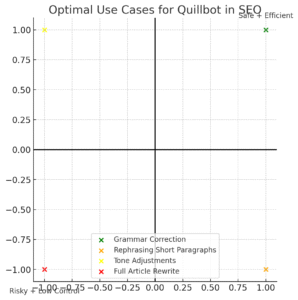
When used responsibly, Quillbot can be an absolute game-changer for productivity and writing quality. It’s not about replacing your creativity — it’s about amplifying it.
Improving Clarity and Readability Without Hurting SEO
We’ve all written sentences that sound fine in our heads but clunky on the page. That’s where Quillbot shines.
Using Fluency mode or Formal mode, you can clean up grammar, fix awkward phrasing, and create smoother transitions — all without changing your message.
For example:
- Original: “SEO writing can sometimes be difficult when you have to keep it both readable and optimized.”
- Quillbot rewrite: “Balancing readability and optimization often makes SEO writing challenging.”
Same meaning, better rhythm — and still SEO-safe.
I recommend using Quillbot at the sentence or paragraph level, not the entire article. That way, you retain your tone and structure while benefiting from AI polish.
Using Quillbot for Grammar Enhancement Instead of Full Rewriting
If you often use Grammarly, Quillbot’s Grammar Checker is a similar feature built right in. You can access it from the top navigation bar: just click Grammar Checker, paste your text, and Quillbot highlights errors instantly.
Unlike a full rewrite, this feature keeps your wording intact — which means your SEO keywords stay perfectly safe.
Here’s my personal workflow:
- Draft content in Google Docs.
- Run it through Quillbot’s Grammar Checker for surface edits.
- Use Fluency mode only on problem paragraphs.
This keeps my SEO intent consistent while still polishing the final copy.
How to Combine Quillbot with Human Editing for Safe SEO Results
The sweet spot lies in balance. I usually follow this hybrid workflow:
- Write the draft manually: Ensure your SEO keywords and structure are in place.
- Use Quillbot for refinement: Polish clarity and flow using Fluency mode.
- Reinsert SEO cues manually: Restore any lost terms like “keyword optimization” or “link building.”
- Proofread with a human eye: Read the content aloud to catch tone mismatches.
Think of it as using AI for editing precision, not creative substitution. That’s the difference between ranking higher and risking a demotion.
Time-Saving Advantages for Content Creators and Copywriters
For busy SEO writers or freelancers juggling multiple clients, Quillbot can save serious time.
A few real-world time-savers:
- Rephrasing outreach emails or meta descriptions in seconds.
- Condensing long product descriptions while maintaining key terms.
- Quickly paraphrasing content snippets for social media.
I’ve used Quillbot to trim a 2,000-word blog draft down to a punchy 1,600 words — without losing context. It’s like having a personal editor on standby 24/7.
The key is using it intentionally — as a time optimizer, not a creativity replacement.
Risks and Limitations of Relying on Quillbot
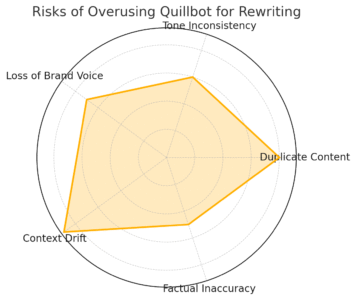
Like any AI tool, Quillbot comes with limitations. It’s a powerful writing aid, but it’s not infallible.
Potential Duplicate Content Issues from Overuse
If you use Quillbot to rewrite someone else’s article without adding unique insight, you’re walking straight into duplicate content territory.
Even though the words are changed, Google’s semantic algorithms can detect near-identical meanings. That can trigger a ranking drop or, worse, manual penalties.
To avoid this, always ensure your rewritten content includes:
- New examples or case studies.
- Updated data or statistics.
- A personal or brand-specific viewpoint.
Quillbot can rewrite — but you must provide originality.
Loss of Brand Voice and Original Style
Brand tone is one of the first casualties of excessive rewriting. Quillbot, while advanced, doesn’t fully grasp nuances like humor, emotion, or rhythm — especially in Creative mode.
If your brand voice is a bit witty or conversational, Quillbot might smooth it out into something generic. That’s fine for academic writing, but it can hurt brand connection in marketing.
Here’s what I recommend:
- Use Quillbot for grammar and fluency.
- Write your intros and conclusions manually — they carry your voice.
- Recheck tone consistency before publishing.
Ethical Concerns Around AI-Assisted Writing
There’s an ongoing debate in the SEO world about whether using AI-assisted rewriting counts as “authentic” writing. Personally, I believe it’s about transparency and intent.
If Quillbot helps you say something better, that’s smart use of technology. If it’s used to churn out content without understanding it, that’s manipulation — and users (and Google) can tell the difference.
Transparency matters. Be open about using AI tools internally, and always prioritize factual integrity over speed.
When Rewriting Becomes a Shortcut That Hurts Content Quality
Here’s where most people slip: relying on Quillbot to do all the writing. That’s like asking a calculator to write your math thesis — it can assist, but not think.
AI can’t replicate first-hand experience, genuine opinion, or human empathy. When you skip those, your content loses heart.
So instead of rewriting everything, use Quillbot to refine your thoughts, not replace them. Google — and your readers — can always tell the difference between a human insight and an algorithmic echo.
Pro Insight: If you treat Quillbot as a polishing partner, not a ghostwriter, it becomes one of the most reliable tools in your SEO toolkit. Let it fix the grammar, flow, and readability — but make sure the story, strategy, and soul come from you.
Best Practices to Use Quillbot Safely for SEO
Using Quillbot for SEO can be incredibly effective — but only if you use it the right way. Like most AI tools, it’s a bit like driving a sports car: powerful, efficient, but dangerous if you hit the gas without knowing how to steer.
The goal is to let Quillbot help you polish your content, not produce it entirely.
How to Balance AI Assistance with Human Creativity
The best SEO content today blends human storytelling with AI precision. Quillbot should be your assistant, not your author.
Here’s how I usually approach it:
- Start Human: Always begin with your own draft. Get your ideas down first — this keeps your voice authentic and ensures your expertise shines through.
- Use Quillbot for Enhancement: Once your draft feels solid, copy it into Quillbot’s Fluency or Formal mode. These modes fix grammar and flow without overhauling your meaning.
- Review and Reinsert Keywords: After rewriting, read through and make sure your focus terms — like SEO strategy, keyword optimization, or Quillbot Rewriter — are still present.
From experience, I’ve found that full rewrites in Creative or Expand mode can make content sound detached, almost sterile. I recommend using those modes only when rewriting sections for tone, not the entire article.
If I were to sum it up: AI gives you structure, but your creativity gives it soul.
The Importance of Manual Fact-Checking and Context Preservation
Quillbot is great at paraphrasing, but it doesn’t understand truth — and that’s a big deal in SEO.
When you rewrite data-heavy or analytical sections, always double-check:
- Statistics: AI can alter numbers, dates, or metrics. Verify these against your sources.
- Quotes: Quillbot may reword or even misattribute them. Keep direct quotes intact.
- Context: Sometimes, it subtly changes meaning (especially with industry terms).
For example, if you’re writing about Google’s Helpful Content Update, Quillbot might rephrase it as a general “content improvement algorithm,” which loses the specific SEO context.
I usually handle this by cross-verifying each section after paraphrasing. I keep my sources open in another tab — and yes, it adds a few minutes, but it saves hours of correction later.
Think of fact-checking as your seatbelt when using AI — you might not need it every time, but you’ll be glad it’s there when you do.
Using SEO Tools Alongside Quillbot for Quality Assurance
To ensure your rewritten content still aligns with SEO best practices, pair Quillbot with dedicated optimization tools.
Here’s a combo that works beautifully in my workflow:
- SurferSEO or NeuronWriter: These analyze your rewritten text for keyword density, topical gaps, and NLP optimization. You can see how well your Quillbot-edited paragraph aligns with what’s ranking.
- Grammarly or Hemingway: These ensure your rewritten text remains readable and free of tone mismatches.
- Originality.ai or GPTZero: If you’re producing content for clients, these tools help confirm that your output still passes AI detection thresholds.
Quick example: after running content through Quillbot, I often paste it into SurferSEO’s content editor. If the content score drops significantly, I know the rewrite diluted key terms — and I tweak it manually.
The rule here is simple: AI polishes, SEO tools validate.
Practical Workflow for Editing AI-Rewritten Texts
If you want a repeatable, safe way to use Quillbot for SEO, here’s a practical step-by-step workflow I personally use:
- Draft Manually: Write your article naturally first. Don’t worry about perfection — just focus on clarity and topic coverage.
- Edit in Quillbot: Paste individual paragraphs (not the whole article) into Fluency mode. Adjust the synonym slider to 2–3 for natural results.
- Reinforce SEO Terms: Check that your primary and secondary keywords are still present. Add them back manually if necessary.
- Fact-Check and Read Aloud: Reading your rewritten text out loud helps spot tone shifts or awkward phrasing.
- Run a Final Optimization Pass: Use a tool like SurferSEO or Frase to make sure your content aligns with the current search intent.
This process keeps your writing sharp, your tone consistent, and your rankings safe.
Expert Opinions on Quillbot and Future SEO Trends
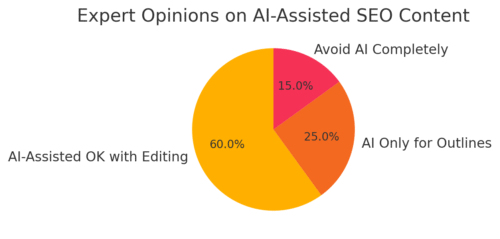
AI writing tools like Quillbot are rewriting the rules of SEO — literally. Many experts agree that the future of SEO isn’t about avoiding AI but learning how to cooperate with it intelligently.
What SEO Thought Leaders Are Saying About AI Writing Tools
Prominent SEO experts like Lily Ray, Aleyda Solis, and Barry Schwartz have shared nuanced takes on tools like Quillbot.
- Lily Ray emphasizes that AI-generated content is fine if it’s edited by humans and adds value.
- Aleyda Solis advises using AI tools for brainstorming or structure — not final output — to keep originality intact.
- Barry Schwartz predicts that Google will continue rewarding human-guided content, not purely algorithmic text.
In essence, the professional consensus is clear: AI is a co-writer, not a replacement.
When I use Quillbot, I think of it as my “editor with no ego.” It catches clumsy phrasing but never makes strategic decisions — those still belong to me.
How AI Content Detection Tools Are Evolving
AI detectors are getting more sophisticated every month. Tools like Originality.ai, Copyleaks, and GPTZero now use perplexity and burstiness patterns to detect AI writing.
However, these tools also adapt — meaning even if your content passes today, future updates might catch older AI-heavy text.
The best protection? Human input. The more personal, nuanced, and experience-driven your content is, the less likely it is to be flagged.
If you’re editing Quillbot output, try adding:
- First-hand experiences or examples.
- Small imperfections (like contractions or casual transitions).
- Personal opinions — something no AI can replicate authentically.
That human touch isn’t just ethical — it’s algorithmically smart.
Predictions on Google’s Future Policies Toward AI-Rewritten Text
Google’s trend is clear: it’s not anti-AI, it’s anti-low-quality. With the rise of the Helpful Content System, Google is prioritizing authenticity and usefulness.
I predict that over the next few years, AI-assisted content will become normal — even expected — but it’ll be held to higher scrutiny. Brands will need to show:
- Transparency: Clear authorship and human oversight.
- Depth: Insights that go beyond surface-level paraphrasing.
- Trust Signals: Verified data, sources, and personal expertise.
In other words, AI will handle the words; humans must handle the wisdom.
What This Means for Content Marketers Moving Forward
For marketers, the message is empowering — not threatening. Quillbot and similar tools can drastically improve workflow efficiency, but the future winners in SEO will be those who blend AI fluency with human authenticity.
If you learn how to:
- Guide AI tools intelligently,
- Edit with SEO precision, and
- Add genuine expertise to your work,
then tools like Quillbot become your advantage — not your liability.
In short, Quillbot can’t replace your voice, but it can amplify it when used with care.
Final Verdict: Is Quillbot Rewriter Safe for SEO?
So, after everything we’ve explored — is Quillbot Rewriter actually safe for SEO? The short answer: Yes, if you use it responsibly. The longer answer: It depends on how human your process remains.
When Quillbot Helps — and When It Hurts
Helps when:
- You use it to polish grammar, clarity, or readability.
- You manually review every paragraph for context and keyword alignment.
- You pair it with SEO tools for validation.
Hurts when:
- You rewrite full articles with no human editing.
- You lose focus on keyword intent or factual accuracy.
- You use it as a shortcut for originality.
It’s like any good tool — a hammer builds or breaks depending on the hand that holds it.
How to Make the Most of AI Without Compromising SEO Integrity
I believe the best approach is to think of Quillbot as a writing amplifier. It should enhance your natural writing voice and SEO awareness, not erase it.
Here’s how you can make it work for you:
- Keep your SEO keywords visible while rewriting.
- Use Fluency mode for safety; avoid Creative for long-form SEO pages.
- Fact-check everything before publishing.
- Edit emotionally — make sure it still sounds like you.
That last step matters more than most realize. Google’s algorithms are designed to reward natural, human-centric writing — the kind only you can produce.
Key Takeaways for Ethical and Effective Use of Rewriting Tools
- AI is a tool, not a replacement. Use Quillbot for refining, not mass-producing.
- Stay human-first. Add your insights, examples, and tone back into the draft.
- Optimize consciously. Always verify SEO keywords and data integrity.
- Balance automation with empathy. Write for readers first, algorithms second.
If I could leave you with one rule of thumb, it’s this: Let Quillbot clean your sentences, but let you clean your message.
Pro Tip: Before you hit publish, copy your final draft into a readability checker like Hemingway or SurferSEO. If it scores well on readability, topical coverage, and keyword relevance — and still sounds like you — that’s when you know you’ve struck the perfect balance between AI power and human creativity.



